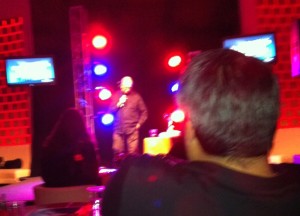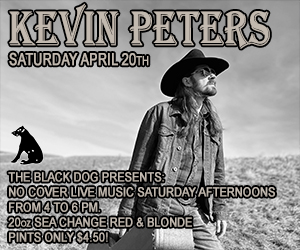EDMONTON COMEDY FESTIVAL: Stand-up harder than it looks
 I have a new found respect for stand-up comedians after walking a mile in their shoes for the first time. It’s not as easy as it looks – and it looks hard enough to begin with.
I have a new found respect for stand-up comedians after walking a mile in their shoes for the first time. It’s not as easy as it looks – and it looks hard enough to begin with.
My three minutes of terror was part of the Edmonton Comedy Festival’s “Funniest Media Person” contest at the River Cree Casino on Oct. 15 – where 630 CHED’s Dan Tencer was judged the winner. Most participants seemed to agree he was the best. He had a joke about seeing an Asian man on an airplane, “Guess what his one piece of carry-on baggage was,” he asked the crowd. “If you said ‘camera,’ you’re racist. Correct, but racist.”
The moments leading up to show time were tense. Most of the other competitors had also never done stand-up before, or very little: Tencer, Tracie Gray (Global TV), Jonny Sullivan (Joe FM), Chris Scheetz (CISN Country), Josh Classen (CTV weatherman) and Morley Scott (CHED sportscaster). Some did relaxation exercises, others consulted their cheat sheets they hoped not to use, and I drank, as we paced the backstage area like caged animals. Having nothing to lose didn’t make a bit of difference. The prize was a trophy and a donation to a charity of the winner’s choice, not that I thought I had a chance. Maybe for a fleeting, foolish moment a couple of weeks ago. I was the only print guy amongst a bill of broadcasters who talk for a living, but those guys were nervous, too. There are few art forms where the performer is as vulnerable as in stand-up comedy.
Organizer and headliner Andrew Grose, who also works for CHED, gave us a pep talk, told us we should treat the experience like a roller coaster ride, “It’s scary, but then you’ll want to do it again.” I found this not entirely true. I went on the Cranium Shaker at Silverwood and have vowed never to go on that stupid ride again.
What’s true is that like a roller coaster, you can’t get off a stand-up comedy routine once you’ve started. You just have to pray you don’t derail before you get to the end. Three minutes can feel like three hours.
Numb from three double rum and cokes and half a pack of cigarettes, I was still as nervous as someone trying to conquer a fear of heights by going skydiving, at that final moment before letting go. I’d prepared some music-related material, making fun of band names and song lyrics, which is all I know how to do, got a look at the crowd and noticed at least half were senior citizens – parents of the competitors and CHED listeners, I presumed – and realized with a creeping chill that many of my mid ‘90s music references would be completely lost on them. Oh, well.
The worst terror, the point at which emcee Graham Neil (another fine local comic) called my name and it was too late to turn back, was banished once I started into my act. As feared, reciting a list of silly band names people had never heard of went over like a lead balloon, the other bits hit and miss, but staying on track wasn’t a problem. This was what you’d call a “good crowd.” No one’s going to heckle. There were some laughs, and though I was certainly wasn’t killing, it wasn’t a complete train wreck, either. My first mistake was writing on such a narrow topic. Some of the comics had plenty of blue material, rich in profanity, stuff about vaginas and hockey, and they were killing. First lesson learned: Universal topics connect better. As my wife put it, “Everybody knows what a vagina is.”
Only once I was actually doing my act for a real audience did I realize something that no amount of planning can reveal: there’s a lot more to stand-up comedy than writing, rehearsing and delivering the jokes. The rule of comedy is that there are no rules to comedy, but every rule is meant to be broken, including that one – so there are rules to comedy. There has to be a rhythm: set-up, punch-line, set-up, punchline, with the length of the set-up directly proportional to how funny the punchline has to be. You can’t follow a strong punchline with a weak one. You can’t introduce irrelevant tangents unless there’s a payoff. And so on. In short, it’s a spoken word art form entirely unlike writing, though there is writing at its core.
There are nuances of live performance, timing, inflection, body language and mannerisms that you can’t learn until you get in front of a live audience – as I had never been – not to mention a certain amount of acting skill. Also, enunciation and voice control are a big help. I realized with a shock that most of these things were missing from my performance within the first few seconds, but I just kept going, and before I knew it I was done, sent off the stage to polite if not enthusiastic applause. I was alive. That’s all that mattered.
I’d happened to talk to comedian Lars Callieou, who was one of the judges, and he told me that everyone should try stand-up comedy at least once, for two reasons: 1. You might be great at it, and there is no better natural high than getting those laughs. And 2. To appreciate how hard it is.
I’m leaning towards door No. 2.
The Edmonton Comedy Festival starts Wednesday and runs until Sunday, Oct. 21 – with real stand-up comics.













